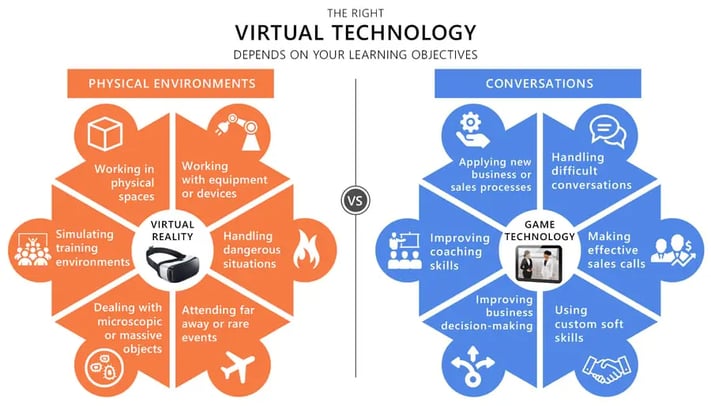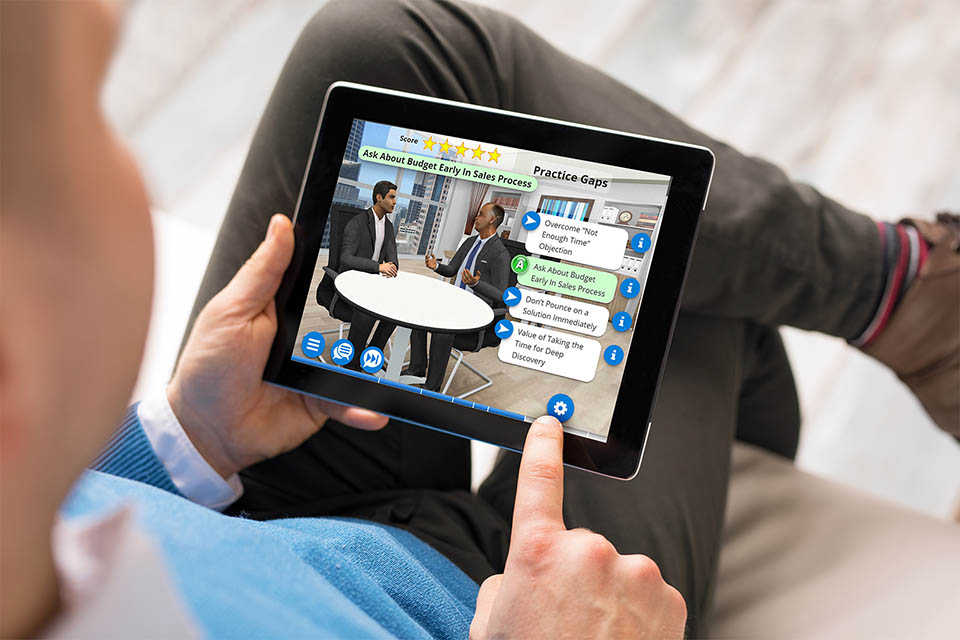.webp?width=711&height=400&name=VirtualTech(16-9).webp)
The future of learning technology is already here. It’s virtual and immersive. It embraces Learn-by-Doing methodologies, and leverages advanced technology within a scalable Platform. Its power comes from the synergistic and catalytic effect of having all five parts working together. Lets take a look at how each of these five parts contribute to an effective virtual learning environment for training.
Let’s begin with the first part: Virtual.
Virtual - to Create a Scalable Solution
We’re not talking “virtual reality” here. (That’s later.) “Virtual” in this case is about escaping the confines of geography to create a scalable solution.
Intuitively, we know going virtual is certainly more cost-effective and practical to implement than live, in-person learning. We’re talking about cloud-based delivery; perhaps as an app, but apps are not as scalable as a browser-based solution.
So, all we need to do is move everything to the cloud and we’re all set, right? Usually not! Learning can easily become much less effective by going virtual; mediocre content can become worse – dreadful and ineffective. So, it’s no surprise that we must do more, much more, to make this endeavor successful. As such, learning must be immersive.
Immersive - to Boost Retention and Engagement
Learning retention starts with the motivation to learn. What’s the best way to do that? Let learners feel like their “in it.” Immerse the learner in an authentic, realistic situation within a safe environment and ask them to make decisions. Immediately, they recognize that either their knowledge is incomplete, or they lack the skills to apply it. After this motivational spark, the learning process begins, and we can coach them until they recognize optimal responses within the situation.
Wait a minute. You may say: “We just need them to understand the rules, the process, what to do, or what not to do. Traditional e-learning does that just fine!” Sure, that’s a knowledge acquisition process, constructing knowledge from information. And one can sometimes argue that that’s all that’s needed, because application of the knowledge is straightforward. However, this is not often the case.
So, then what? Well, then we need to do more.
Immersion helps provide motivation, develop skill, and improve retention. Immersion also helps learners to construct mental models that are robust enough to guide effective performance in real-world situations
Immersion matters. Realism matters. And the cognitive science behind the Learn-by-Doing approach provides evidence for why this is true.
.webp?width=711&height=400&name=Neurons(cropped).webp)
Learn-by-Doing - to Transfer Knowledge
It all comes down to learning effectiveness, doesn’t it? We know about the Forgetting Curve, and we know that performance often hinges on applying knowledge properly – the “doing” rather than the “knowing.” Learning to apply knowledge – skill acquisition – is the catalyst to achieve performance. This is not easy.
Fortunately, cognitive science provides guidance on how to help learners master rapid skill acquisition. Making optimal decisions in dynamic, fluid, situations based on acquired knowledge takes practice. So, we begin with:
- Experiential Learning: learn by doing. Practice makes perfect, right? Trial and error though, is not efficacious. So, we need to do more.
- Cognitive Apprenticeship takes the ancient, proven apprenticeship model for physical skills and applies it to decision-making. Its major tenets are to expose expert mental models to the learner via coaching. Coaching is transformational, rapidly accelerating what is learned from practice.
- Situated Cognition tells us that the practice should be as realistic as possible.
- Cognitive Flexibility suggests that the experiential learning environment should expose learners to multiple perspectives. Such experience creates a more robust mental model that holds up when the learner applies what they practiced in real situations.
Intuitively, we know how to effectively apply these concepts one-on-one. The enormous challenge is how to do it virtually. If it’s not done well, the initiative falls flat. It all hinges on the technology deployed.
Technology - to Bring Virtual Environments to Life
How do we implement Virtual – Immersive – Learn-by-Doing? What technologies should we consider?
Virtual Reality
It's new and exciting! If the learning objectives require interacting with a physical environment, its a great fit. Because its new, applications in training are highly customized, expensive, and difficult to modify later. VR requires an investment in headset and the headset does limit access to learners.
Virtual Game Technology
Its essentially the same technology as VR, but without the headset. Therefore, game technology can be accessed on any device, including mobile. When the learning objectives focus on conversations, interacting with conversational virtual humans is a great fit for virtual game technology.

This is exciting. But, technology alone is not a solution, ideally we need a complete platform to make it a strategic investment.
Platform - to Cost Effectively Build Content
A platform brings all these components together and delivers several benefits:
Scale
A platform can ideally deliver learning experiences to any modern device, anytime, anywhere via an internet connection. When browser based, virtual learning modules can also be affordably accessed via a Software-as-a-Service (SaaS) model, instead of maintaining disparate apps across PCs, Macs, iOS, and Android.
Content Maintainability and Consistency
A platform should include standardized, cost-effective ways to build interactive environments and modify modules over time. This is often overlooked with "one-off" projects or selecting fast moving technology which cannot maintain compatibility over time.
Analytics
Measurement of learning outcomes is another critical piece. It’s essential that any platform we choose includes analytics. Many interactive programs consider analytics as an afterthought and do a poor job. That’s a missed opportunity.
Because learners are being placed in authentic situations within an experiential learning environment, you can measure how they are doing, where they struggle, and where they succeed. To do this effectively, the interactive software must be built from the ground up to collect and measure outcomes. With measurement in place, we can deploy a complete learning engine.
Such a platform can have application across diverse areas such as education, clinical training, leadership development, sales training, patient coaching, role playing, talent development, and employee performance.
A solution, like that incorporates all these components (see example here), can help organization take their training to the next level, where "knowing" is transformed into "doing" and improved performance.
About Syandus: Virtual immersive learning technology that transforms knowledge into real-world performance. We immerse participants in realistic virtual situations with one-on-one expert coaching that gives them experience making optimal decisions. Syandus Learning Modules combine cognitive science principles, the realism of game technology, and our customer’s proprietary content, to deliver rapid skill acquisition. Modules are cloud-based for easy deployment, fully trackable with embedded analytics, and can be used on any web-enabled device.



